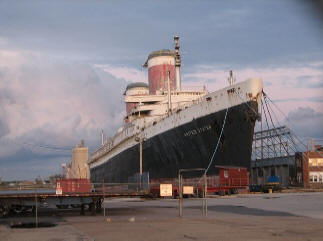|
||||||||||||
|
||||||||||||
|
|
|
|||||||||||
|
Back to News Menu Cruise News for the Corporate Travel Professional February 2016 |
||||||||||||
| The S.S. United States has just been tossed a life preserver. | ||||||||||||
|
In its 1950s heyday, the historic ship — the world’s fastest luxury liner — dashed across the Atlantic carrying royalty and immigrants alike to American shores. But for nearly a half century now the “Big U,” as the ship is known, has been docked, collecting barnacles and rust after jet travel lured away all the customers. Now, however, there is a chance the S.S. United States may sail again, after Crystal Cruises, a luxury travel company, signed a purchase option for the ship. Just months earlier, preservationists almost had to scrap the Titanic-size vessel as their funds dwindled.
The 2,000-passenger Big U, about as long as the Chrysler Building is tall, still holds the record for the fastest crossing of the Atlantic, which it set on its 1952 inaugural round trip between New York and Europe. Its top speed remained a secret for decades during the Cold War. More recently, the vessel has struggled to find a purpose. With a gift from a Philadelphia philanthropist, a conservancy bought the ship a few years ago from the cruise operator NCL, which was close to scrapping it. But fund-raising has been a struggle, and late last year the preservationists themselves had to think seriously about scrapping their prize. “The prospect of the ship’s return to seagoing service was a dream we’d basically given up on because of the technological challenges,” said Susan L. Gibbs, executive director of the S.S. United States Conservancy, the group that owns the vessel. But Crystal, which is expanding its lineup of vessels, saw potential, Ms. Rodriguez said. She and the company’s chairman, Tan Sri Lim Kok Thay, decided that it would be a “crime” if the ship were melted down. Crystal is owned by Genting Hong Kong, which holds a stake in NCL, the ship’s former owner. Mr. Lim is also Genting’s chief executive, which makes this his second experience with the S.S. United States. Crystal said it planned to turn the ship into an 800-passenger luxury liner that will travel the world and perhaps even resume occasional service between New York and Europe, the classic route it served along with ships like the R.M.S. Queen Mary, the S.S. France and other great liners of the mid-20th century. The Queen Mary is now a stationary hotel in Long Beach, Calif. The France was renamed the S.S. Norway, then was scrapped. A concept rendering of the S.S. United States makeover shows a ship with its signature twin red, white and blue stacks and the same number of decks, a spokesman said, in contrast with the top-heavy silhouette of some modern cruise liners. The decks, however, are extended and expanded to accommodate rooms with balconies, something the original design never had. Crystal’s interest in refitting the ship, while quixotic, is not entirely without business logic. If the ship proves to be sound, it provides the head start of a hull in place, a potential cost advantage. The ship also happens to be the rare ocean liner that was built and flagged in America, which can make it easier to service some American routes where foreign-flagged vessels can face limitations. Still, there are big challenges. It is a steam engine ship, (that’s the “S.S.” in the name), and the geriatric equipment would have to be swapped out. The last time the ship moved under its own power was more than 40 years ago. Furthermore, some engineering areas contain
toxic PCBs. It is a common problem for ships of the period, but one that means
the Environmental Protection Agency will take an interest. A budget of $100,000 for an addition, she said, can balloon to $200,000 “because you couldn’t get permits, because of the foundation.” That, she said, would be a “showstopper.” |
||||||||||||
|
Worldwide Travel & Cruise Assoc., Inc. 150 S. University Dr. Ste E, Plantation, FL 33324 - USA Tel: +1 954 452 8800 Fax: +1 954 252 3945 |
||||||||||||
|
Designed & Published by: Worldwide Media. |
||||||||||||


 to $800 million, according to Crystal’s chief executive, Edie Rodriguez,
potentially a little less than building something similar from scratch. Under
terms of the agreement, the company will cover the approximately $60,000-a-month
cost of caring for the ship for nine months while it does a feasibility study.
to $800 million, according to Crystal’s chief executive, Edie Rodriguez,
potentially a little less than building something similar from scratch. Under
terms of the agreement, the company will cover the approximately $60,000-a-month
cost of caring for the ship for nine months while it does a feasibility study.